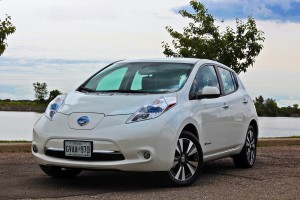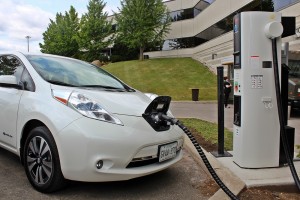This past week, a number of automotive journalists were able to preview and learn about new features and enhancements for the 2015 model year of the all electric, zero-emission Nissan Leaf.
The preview, which involved a driving component also included a stop at Nissan Canada headquarters in Mississauga, ON and a demonstration of it’s Level 3 DC fast-charge unit – one of only 2 Level 3 units available for use in all capable EV’s currently installed in Ontario.
There are no structural changes or changes to the total range of the Nissan Leaf with the 2015 model. A next-generation Nissan Leaf is widely expected to be launched with the 2016 model, so all hoped for enhancements will be put on hold for at least another year.
For the 2015 model, integrated connectivity features have been added. Available on SV and SL trim levels, Leaf drivers will now be able to use voice activation technology to communicate with their vehicle as well as hands free text messaging.
Also announced was that the base S model trim will also include the heavy-regenerative B Drive mode, previously only available on SV and SL trims. When driving in B mode, there is an enhanced regenerative process that takes place whenever the foot is not on the accelerator. It’s heavier action will slow down the vehicle and provide maximum regeneration to the battery. In certain situations my use of this feature has added to the range of the vehicle, even as I go along.
Wireless technology is further enhanced through Nissan’s Carwing technology, which allows Leaf owners to interact with their Leaf via their smartphone. Available for iPhone, Android, and in Canada Blackberry users (Z10 and Z30 only), Carwings allows Leaf owners to schedule charging times to take advantage of time of use rates. In addition, Carwings allows owners to begin the heating or cooling of their Leaf while the vehicle is still plugged into the charging source. This allows for the owner to enter the vehicle in an optimized climate while not using any of the battery charge to do so. This is an innovative feature which helps maximize the driving range of the vehicle.
Pricing for the 2015 Nissan Leaf in Canadian dollars for the S trim is $31,798. For the mid-range SV trim, pricing is set at $35,048 and for the top-end SL trim, you’ll drive away starting at $38,548. Rebates remain available for purchasers in Ontario and Quebec, while British Columbia recently ended it’s EV rebate program.
For my original video review of the Nissan Leaf, please click here.
The Level 3 DC fast charge demonstration showed a glimpse of what the future may look like for convenient and effective charging of electric vehicles. Level 3 chargers will bring vehicles to an 80% charge level in only 30 minutes – a significant reduction from Level 2 chargers which often take between 4 – 5 hours to fully charge. Outside of Tesla’s proprietary Quick Charge units, there are only 2 Level 3 chargers currently operating in Ontario. Unfortunately they are only about 5 minutes from each other as one is located at Nissan Canada’s headquarters with the other being found at the nearby headquarters of Mitsubishi Canada. Noteworthy is the fact that, at least for the time being, there is no charge to use the Level 3 unit and can be used by all EV’s and not just Nissan Leafs.
The implementation and installation of Level 3 units in an effective manner will go a long way towards rapid acceptance and adoption of EV’s in Canada. I have long believed that shopping centres should be hubs for fast charge units. Given that drivers would need to stop for approximately 30 minutes or less, a shopping centre would be wise to install units and establish a system where a fee would be levied to ‘fill up’ the battery, however that fee would be waved if during the charge time the drivers went and made purchases within the mall. It’s a formula that would be win-win for both, and should produce an effective ROI against the rather hefty current costs to install.
Admittedly cost is not the only criteria causing a delay as there still remains uncertainty as to what type of fast charger will ultimately dominate and become the standard. BMW has created a lighter and virtually portable supercharger unit as an example, so time will tell how fast charging infrastructure will continue to roll out.
More information on the 2015 Nissan Leaf is available through the Nissan Canada website.



We bring over a decade of online automotive experience, specializing in sales, management and consumer advocacy and are committed to bringing together dealers and real customers with a trendy and social source of information.
http://www.dealerdirt.com